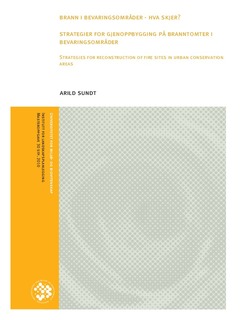| dc.description.abstract | I denne oppgaven ser jeg nærmere på bakgrunnen for at ulike strategier velges når nybygg skal tilpasses historisk bymiljø. Utgangspunktet er branntomter i bevaringsområder som skal gjenoppbygges. Prosjekter som dette har vist ulike strategier for tilpassing av nybygg til konteksten. Tilnærmingen til møtet mellom gammelt og nytt varierer med ulike stilperioder. Det oppstod et skille i synet på historiens plass ved utvikling i historiske bymiljø i overgangen fra modernismen, hvor det historiske aspekt ble ignorert, til den postmodernistiske, hvor historien vektlegges i utviklingen. Innenfor postmodernismen er det imidlertid også et bredt spenn i tilnærming til historien. Dette har gitt plass til de ulike strategiene, som på ulikt vis involverer det historiske aspekt i utforming og tilpasning av nybygg i historiske bymiljø. Strategiene diskuteres i lys av tre kategorier og synliggjøres gjennom tre case hvor tidligere
bebyggelse har gått tapt i brann og ny bebyggelse skal tilpasses konteksten. Den første strategien er kontrast som innebærer et bevisst ønske om å utforme et nybygg i samtidens formspråk som skiller nytt og gammelt. Den andre er konteksttilpasning, en strategi som ble fremmet gjennom postmodernismens vektlegging av lokalt særpreg i utformingen, hvor byens
eller områdets karakter tilstrebes anvendt i utforming. Den tredje er rekonstruksjon av
tidligere bygning og innebærer et ønske om å bringe tilbake kjente elementer i bybildet.
Studien identifiserer et skille i aktørers verdivurderinger – dette utgjør et mønster i hvilke argumenter ulike aktører bruker i strategidiskusjoner og rundt identitetsspørsmål. Befolkning
argumenterer med gjenkjennelsesverdi, kommunen merkevareverdi og eier med praktiske argumenter. Case viser at valg av gjenoppbyggingsstrategi på branntomter i bevaringsområder i større grad kommer på bakgrunn av en drakamp mellom ulike maktfaktorer og -aktører, enn de rent teoretiske tilnærmingene til bruk av strategiene ut fra utformingsmessige argumenter. Casestudie viser at valg av strategi vil komme på bakgrunn av praksis i kommunen (hvorvidt gjeldende planer er overholdt), konteksten (bygningsmiljøets uttrykk og utforming, historie og
historisk utvikling) og brannens omfang (større omfang gir større avvik, mer markant utforming av nybygg grunnet større volum skal gjenoppbygges). Bakgrunnen for at ulike strategier velges ligger i maktfaktorers og -aktørers innbyrdes varierende forhold og
varierende avhengighetsgrad i relasjonen mellom disse, konteksten og praksis på stedet. This thesis will explain the reason why the different strategies chosen to adapt new buildings to a historical urban environment. The basis for my research is the fire sites in conservation areas to be rebuilt and that different strategies have been chosen for adapting the new
buildings to its context in the aftermath of a fire or similar sudden events. The approach to the meeting between old and new varies in different style periods. A distinction in view of the history of spatial development in the historic urban environment arose in the transition from modernism, where the historical aspect was ignored, to the post-modernist, where the history is emphasized in the development. Within postmodernism, it is also a wide range of approaches to the history. This has opened up to a range of strategies for different ways to
involve the historical aspect of the design and adaptation of new construction in the historic urban environment. The strategies are discussed through a typology of three categories which are made visible
through three cases where previous buildings have been lost in fires and the objective is to adapt new buildings to the historical context. The first strategy is contrast, with the desire to consciously design a new building in the contemporary idiom that distinguishes new and old.
The second is contextual adaptation, a strategy that was promoted by postmodernism emphasis on local character and design, and where the city`s character is applied in the design of new buildings. The third is reconstruction of former buildings that implies a desire to bring
back the old, familiar elements in the cityscape. The case study identifies a distinction in valuations among the actors, and a pattern in which different actors use arguments in the strategy and identity discussions. Inhabitants argue with the value of recognition, municipality with branding value, owners with practical arguments. My case study shows that the choice of strategy for reconstruction at the fire sites to a greater extent are based on a power struggle between various agents of change, than the purely theoretical approaches to the use of strategies based on design-related arguments. Case study
shows that the choice of strategy will be based on whether current plans are in fact adhered to when projects are materialized, the context of the building environment and the impact of the fire. The reason behind the different strategies chosen seems to lie in varying conditions between agents of change intrinsically and various degrees of dependence in the relationship
between these agents, the context of the building environment, and the planning practice in the city. | en_US |
